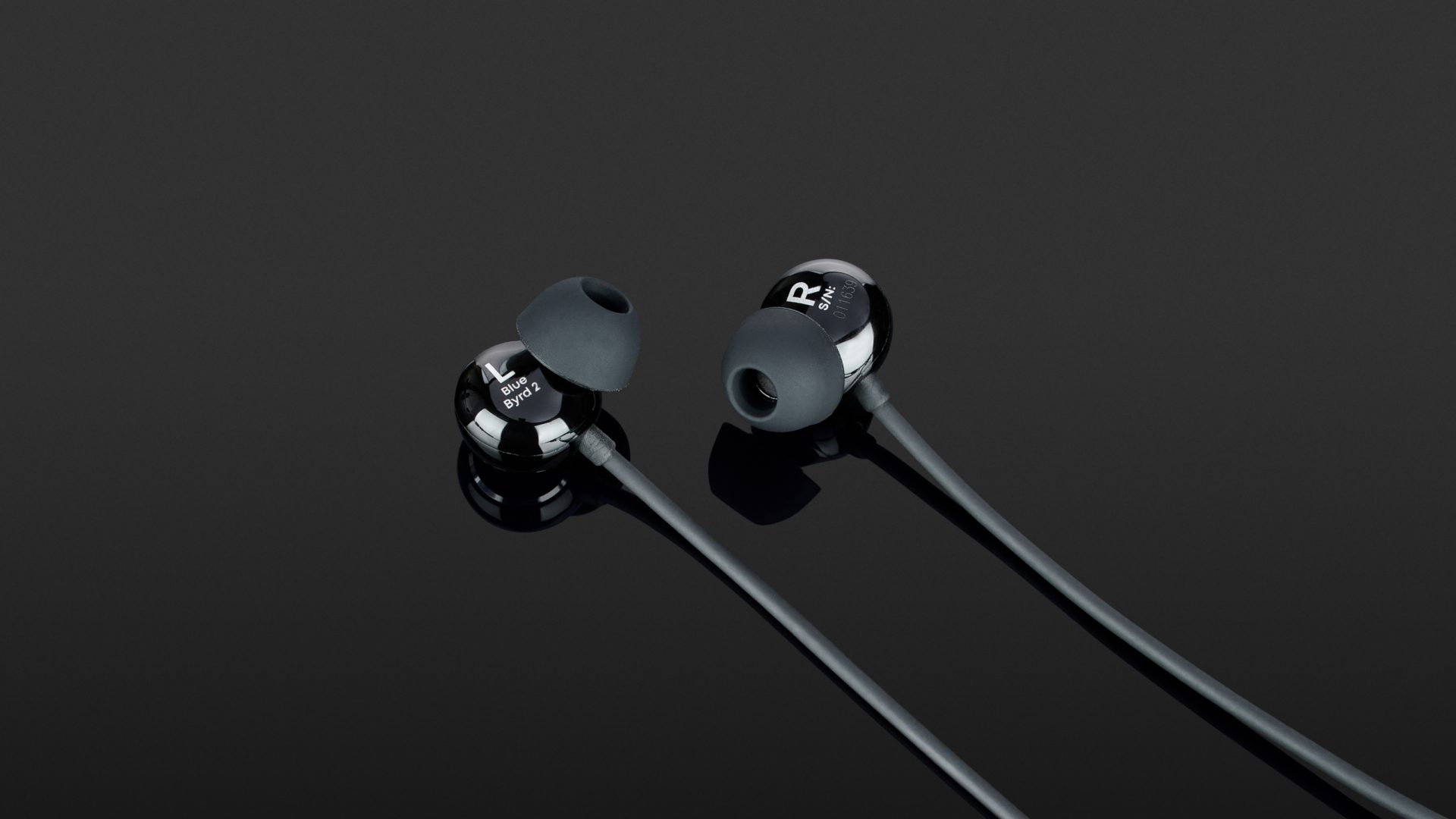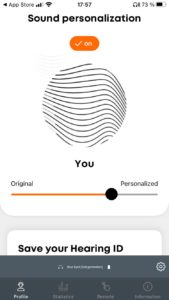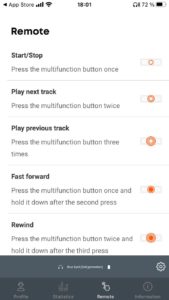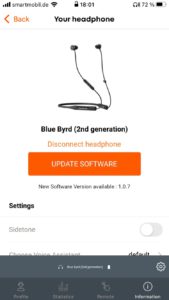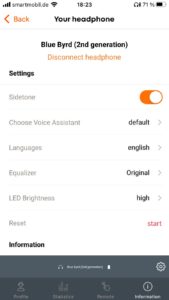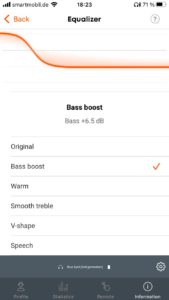The Beyerdynamic Blue Byrd (2nd generation) is offered at an attractive price of around 129 euros and leaves a positive impression throughout. The wearing comfort of the neckband design is high, the battery performance is convincing, and the sound of these particularly lightweight headphones is powerful and ideally suited for mobile use. In addition, these headphones are suitable for sports, film and office use. The sound personalisation is an exciting extra that is not found everywhere and, when used correctly, represents definite added value.
The new Beyerdynamic Blue Byrd (2nd generation) offer convincing wearing comfort, practical high battery performance and a powerful sound image including sound personalisation at an exciting price of about 129 euros. They are therefore ideally suited for mobile and sports use.
Visually, little has changed compared to the previous model, the Blue Byrd. The second generation of the Blue Byrd is still a pair of headphones for everyday mobile use, not a sophisticated designer item. The flexible band of the new Blue Byrd is also placed around the neck to guide the drivers into the ears. The all-black design is subtle in its appearance, the workmanship in keeping with the price class.
On the right side, there is the 3-button remote with an integrated microphone for phone calls as well as the USB-C charging port, which allows the headphones to be used directly with a computer. On the left is the on/off switch.
In all cases, these are fixed, non-interchangeable cable connections.
Technical
Technically, the new Blue Byrd (firmware 1.07) works with Bluetooth 5.2 and supports the audio codecs SBC, AAC and aptX Adaptive – a reasonable feature set for this price range. The latter codec replaces the predecessor aptX LL and, like the latter, also enables minimised latencies for the lowest possible offset of picture and sound. In addition, the Blue Byrd supports multipoint so that two devices can be connected to the headphones at the same time. Another plus point is the USB-C connection: These in-ears can not only be used via Bluetooth while being charged at the same time, but they also support audio transmission via USB. In this way, the Blue Byrd also become a small audio interface for laptops, tablets and the like, offering resolutions of up to 16-bit/48kHz.
The battery life of up to 14 hours with the possibility of a quick-charge function is also impressive. This should be enough for longer trips and is a real added value compared to its predecessor. The Blue Byrd comes with a hard case, which, as expected, is significantly larger than that of True Wireless solutions.
Practice
The neckband concept is somewhat out of fashion nowadays, but it still has advantages, and rightly so. In no time at all, you can take the earphones out of your ear and simply let them dangle, although it bothered me that these headphones do not adhere magnetically to each other. Due to their design, the batteries do not need to fit in the earpieces, which is why they are compact and very light. In fact, the design is so flat that the earpieces hardly bothered me even when I was lying down.
The resulting wearing comfort is high. And for me, at least, wearing these earpieces with the correct fitting piece from the five silicone ones provided was comfortable, pressure-free, secure and gave good passive attenuation to boot. But I will admit: It did seem slightly antiquated to have to switch the headphones on and off manually.
I didn’t notice any drop-outs from the Bluetooth in my test. I can also report fast pairing and a stable connection with an iPhone 8, which lasted across several rooms.
Control on the device is via three mechanical, easy-to-touch buttons. These enable volume control as well as starting/stopping playback, track skipping, fast-forwarding and rewinding, answering, rejecting and ending phone calls and calling the voice assistant (Siri, Google Assistant, Alexa).
The free “MIY” app (iOS, Android) offers further convenience. Here, for example, you will find an equaliser with five pre-sets (bass boost, speech, etc.), but unfortunately without any customisation options. However, there is control over the duration and level of music consumption. The “Sidetone” option can also be activated in the app, which, according to the manufacturer, is supposed to improve the audibility of one’s own voice during phone calls by transmitting it to the drivers via the microphone. The speech intelligibility during phone calls was indeed high and was supported by Qualcomm cVc noise reduction. The extent to which one finds the Sidetone function beneficial in this regard is likely to be dependent on the individual user.
MOSAYC sound personalisation
As with its predecessor, there is a sound personalisation feature from Mimi Defined called “MOSAYC”, which is designed to adapt the sound to the user’s ears. In this listening test, various test tones are played to both ears, and these must be confirmed against background noise for the period of their audibility. Subsequently, a hearing profile is calculated, and this is also dependent on the age of the listener. The aim of this correction is to compensate for hearing deficiencies. The correction curve can be applied to the music signal with variable intensity, with quite distinct results. For example, the circuit creates a more open treble range and a positive emphasis of the lower frequencies. The effect, although more complex in its implementation, could, at least in my case, be compared to an adjustable loudness function. However, this is accompanied by a level increase, which actually makes real A/B comparisons impossible. Unfortunately, switching between the different listening profiles of different users is still not offered.
Sound
As mentioned, the sound personalisation of the Beyerdynamic Blue Byrd (2nd generation) clearly influences the sound result, which is why the corresponding control setting has to be taken into account. I had the impression that the personalisation could be turned up further than in my test of the first version without disturbing side effects in the bass range. For my test, I chose a setting of 60%, which was already considerably punchier compared to the neutral position.
In this position, the Blue Byrd operated at a high level without disturbing the person sitting next to them. It delivers a powerful bass that never sounds annoyingly overemphasised (tested with iPhone 8). The deep bass in Goldfrapp’s “Systemagic”, for example, made my eardrums flutter. This performance cannot be called neutral, but the listening pleasure was there from the first bar.
Although the Blue Byrd is powerful, it is still tight enough to provide the necessary dynamic and tonal information. This also applies to Mark Tremonti’s current album “Marching in Time”. Here, the closed, dynamic driver design clearly demonstrates how it richly combines distorted guitars and rock drums.
The midrange offers good resolution, putting vocals and instruments from acoustic to electric to electronic in the right light. The differences between mixes nevertheless quickly become apparent: for example, the guitars in Slayer’s “Repentless” have a slightly too prominent midrange nose, while “They Lie” by Exploited comes across as a little too lifeless and treble-emphasised in this department. You probably won’t want to use these headphones as an incorruptible mixing tool, but that’s not what they’re designed for.
The unit I tested was open enough at the top end, but at the same time pushing the limits of harshness, for example with Britney Spears “Toxic”.
The stereo panorama was wide and stable. In contrast, the spatial depth was typically less pronounced than in devices of this type. In short: an appealing performance.
Technical specifications
- Ear couplingIn-ear
- Typeclosed
- Transducer principledynamic
- Frequency response (headphones)10 - 20.000 Hz
- Weight with cable32 g
What's in the box
- 5 pairs of silicone ear tips (XS, S, M, L, XL)
- USB cable for charging and data transfer
- Hardcase
Special features
- BT codecs: SBC, AAC, aptX, aptX Adaptive
- BT version: 5.2
- BT profiles: HSP 1.2, HFP 1.7.1, A2DP 1.3.1, AVRCP 1.6, AVCTP 1.4, AVDTP 1.3, SPP 1.2, Device ID 1.3, RFCOMM1.2, GAVDP 1.3













